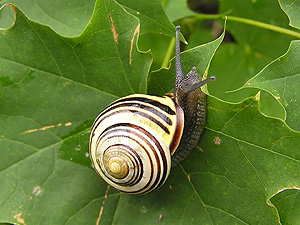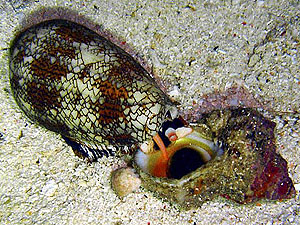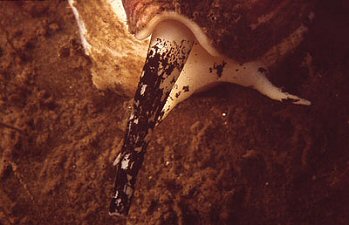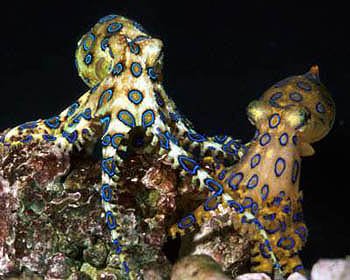
Klingons studying malacology.
 Klingons studying malacology. |
What do the Klingons, the irascible, but honourable counterparts of the Federation in the TV series Star Trek, have to do with molluscs? Not much, one should think, as they are a merely fictitious civilization.
 A peaceful grove snail (Cepaea nemoralis). |
On the other hand, if one takes the time to cast a glance on Klingon society, evolved through battle and competition, and on whose home planet Qo'noS (spoken Kronos), as the Klingons say, there are so many carnivorous and otherwise dangerous animals that a member of the Federation would not even dare to take his dog for a walk, one can lively imagine, what the molluscs on that planet could look like.
And the most interesting thing is: We need not even to travel to Qo'noS, comparable molluscs are abundantly present on our own home planet.
Let us take the snails. The general picture of a snail is a peaceful little creature crawling its way at a literal snail's pace and mainly feeding on cabbage. The harmless snails are hunted by everyone – gardeners poison them, the French eat them, and not even the native fauna is friendly towards them: Toads, blindworms, hedgehogs and finally the song thrush, all are after them.
 Cone shell (Conus textile, left) feeding on a turban shell (Turbo sp.). Source: conchology.be (Guido T. Poppe). |
To prove this peaceful snail prejudice lies, there are also species among the gastropods that could by all means come from the Klingon home world. Cone shells (Conidae) are sea living gastropods hunting fish (the larger species), other molluscs and worms (the smaller species). They do so with a venom dart, which has developed from their rasp tongue or radula. Cone shells are among the most beautiful sea shells (which as such is species, because there are so many of them), but they can even be dangerous to divers.
 Euglandina feeding on a Bradybaena similaris. Picture: Bill Frank, Jacksonville Shell Club. |
On land there are carnivorous snails of the rosy wolf snail (Euglandina rosea) kind. Knowing those, one should be happy they are only some centimetres long: Wolf snails hunt other snails, pursuing their slime trace, through water and up trees. Then they feed on their prey, whole if the other snail is sufficiently small, or piecemeal, alive of course, if the prey is larger.
In their kind, wolf snails and their family, the Oleacinidae, are by no means exceptions: In South Africa, a garden owner wanted to save a snail from the gruesome death by the lawn mower. For this he was rewarded with a bleeding bite to the thumb – the snail was Natalina cafra, a local predator snail.
![]() The Hannibal Lecter snails on the
Snails Tales Blog.
The Hannibal Lecter snails on the
Snails Tales Blog.
Other examples from the world of snails could include the tritons' horns (Ranellidae) hunting sea stars, or the muricid shells (Muricidae), among which not only are the famous purple shells, but also the tiny oyster drill (Ocenebra erinacea), so called because its favourite way of hunting is to drill through the shell of oysters and other molluscs to feed on them.
The following movie by BBC Earth very finely shows how a tulip snail (Fasciolaria tulipa), by the way a predator itself, attempts to escape a giant horse conch (Pleuroploca gigantea).
![]() Giant Horse Conch and Burglar Hermit Crabs!
Quelle: BBC Earth auf
YouTube.
Giant Horse Conch and Burglar Hermit Crabs!
Quelle: BBC Earth auf
YouTube.
But Pleuroploca gigantea, to the unlucky tulip snail's disadvantage, is the largest gastropod species in the western hemisphere. Though it is called a "horse conch" in English, it is not a conch (Strombus), but a relative of the European common whelk (Buccinum undatum).
 Common whelk (Buccinum undatum). Picture: Peter Jonas, Unterwasser-Welt Ostsee. |
When a whelk (Buccinum undatum) has a foot in the door, life is about done: Actually whelks squeeze their foot between the shell halves of a mussel to prevent the mollusc from closing up; the only defence a mussel would have against so large a predatory snail.
Against smaller predatory snails, mussels are well capable to defend themselves: They tie them down with byssus thread until the snail cannot move anymore and probably even has to starve.
 Female blue ringed octopus in aggressive mood (left). Photo: Roy Caldwell. |
Klingon behaviour, of course, is not restricted to snails. Let us cast a glance on blue ringed octopuses (e.g. Hapalochlaena lunulata): They are certainly pretty, but as they say: "The prettiest are the deadliest." Generally, octopuses use their poisonous saliva to paralyze their prey and to dissolve their tissue.
A blue ringed octopus' saliva, however, is as deadly as the venom of one of the many snakes in their Australian home: The blue ringed octopuses of Australia and South East Asia contain enough tetrodoxin (the poison of the puffer fish) to kill an adult human.
And from time to time, careless beach wanderers die after having picked up one of the inconspicuous small octopuses, waiting for high tide in a tide pool to return into the sea: Blue ringed octopuses show their blue rings only when they are angry or feel threatened.
On the other hand, even the blue ringed octopuses' deadly tetrodoxin venom does not protect it from all of its enemies. For example, the peacock mantis shrimp appears to have developed a resistance against a blue ringed octopuses' venom and so can catch it and eat it - besides, the mantis shrimp is so much larger than the octopus.
![]() Peacock
Mantis Shrimp kills Blue-ringed Octopus: Film by Roy
L. Caldwell on youtube.com.
Peacock
Mantis Shrimp kills Blue-ringed Octopus: Film by Roy
L. Caldwell on youtube.com.
Those few examples teach us that the most interesting alien life forms live among us on our earth and that some of them would put drops of sweat even on a Klingon's forehead, were they only a little bit larger…
Dedicated to the Imperial Klingon Cruiser Iw' wa'DIch and the Freiburg StarTrek Dinner!